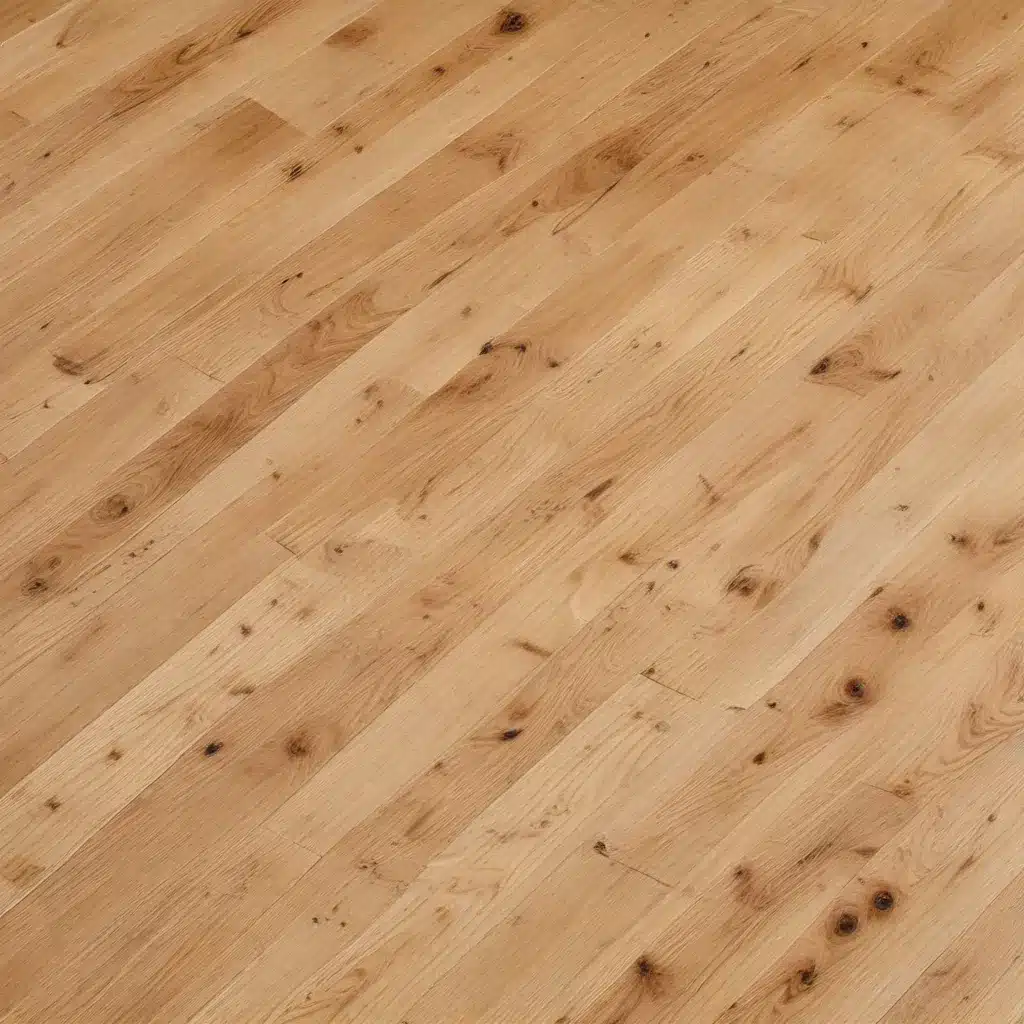
Unlocking the Timeless Charm of Oak Flooring
Oak flooring is a timeless classic that has graced homes for centuries, prized for its unique character, durability, and unparalleled beauty. As a seasoned expert in the field, I’ve had the privilege of guiding homeowners and contractors through the intricate world of oak flooring, from selection and installation to finishing techniques and sustainable solutions. In this comprehensive guide, we’ll dive deep into the art of maintaining your oak floors, ensuring they retain their stunning appearance and resilience for years to come.
Choosing the Right Polyurethane Finish
When it comes to oak flooring, the choice between water-based and oil-based polyurethane finishes is crucial. Each option offers distinct advantages and considerations that can impact the overall look, feel, and longevity of your floors.
Water-Based Polyurethane:
– Environmental Impact: Water-based polyurethanes are generally more eco-friendly, as they emit fewer volatile organic compounds (VOCs) during the application process.
– Appearance: These finishes tend to maintain a clear, natural appearance, allowing the inherent beauty of oak’s grain and color to shine through.
– Durability: While water-based polyurethanes are durable, they may not offer the same level of long-term wear resistance as their oil-based counterparts.
Oil-Based Polyurethane:
– Durability: Oil-based polyurethanes are known for their exceptional durability, making them a popular choice for high-traffic areas or homes with active lifestyles.
– Appearance: These finishes can impart a subtle amber tone to the oak, enhancing its warmth and depth.
– Drawbacks: Oil-based polyurethanes require more extensive cleanup, using mineral spirits, and can be less environmentally friendly due to their higher VOC content.
When deciding between water-based and oil-based polyurethane, consider your priorities, such as the desired aesthetic, the level of foot traffic in your home, and your commitment to sustainable practices. Consulting with a flooring specialist can help you make an informed decision that aligns with your unique needs and preferences.
Preparing Your Oak Floors for Polyurethane
Before applying polyurethane to your oak floors, proper preparation is essential to achieve a flawless finish. This process involves three critical steps: sanding, cleaning, and sealing.
Sanding:
Sanding is the foundation for a successful polyurethane application. This step removes any existing finishes or imperfections in the wood, creating a smooth, even surface for the new coating to adhere to.
Cleaning:
Once the sanding is complete, it’s crucial to thoroughly clean the floors, removing all dust and debris. This ensures the polyurethane bonds seamlessly with the wood, preventing any unsightly blemishes or inconsistencies.
Sealing:
After cleaning, the floors should be sealed to create a barrier that enhances the polyurethane’s adhesion and longevity. This step also helps to prevent any potential bleed-through of the wood’s natural tannins, which can discolor the finish over time.
By meticulously following these preparatory steps, you’ll lay the groundwork for a stunning, long-lasting polyurethane finish that showcases the natural beauty of your oak floors.
Applying Polyurethane with Precision
With the floors prepped and ready, it’s time to apply the polyurethane. This process requires patience and attention to detail to achieve a smooth, uniform finish.
Application Techniques:
– Brush or Roller: Use a high-quality brush or roller designed for polyurethane application, ensuring even coverage and minimizing visible brush strokes.
– Thin Coats: Apply the polyurethane in thin, even coats, allowing each layer to dry completely before applying the next. This helps prevent bubbles, ridges, or an uneven finish.
– Sanding Between Coats: Gently sand the surface with fine-grit sandpaper between coats to create a smooth, uniform surface for the next layer of polyurethane.
Drying Time and Curing:
– Drying Time: Follow the manufacturer’s recommended drying times between coats, typically ranging from 4 to 8 hours, depending on the product and environmental conditions.
– Curing Time: Allow the final coat of polyurethane to fully cure, which can take up to 30 days, before subjecting the floors to heavy traffic or placing furniture on them.
Avoiding Common Pitfalls:
– Dust and Debris: Take measures to minimize dust and debris during the application process, as even the smallest particles can get trapped in the finish, creating an uneven or bumpy surface.
– Overlapping Edges: Be careful when applying polyurethane near edges and corners, ensuring a seamless transition and avoiding visible lines or streaks.
By meticulously following these application techniques and drying/curing guidelines, you’ll ensure a flawless, long-lasting polyurethane finish that accentuates the natural beauty of your oak floors.
Selecting the Ideal Finish: Satin, Matte, or Gloss
The final step in mastering oak flooring care and maintenance is choosing the right finish: satin, matte, or gloss. Each option offers a unique aesthetic and level of maintenance, allowing you to tailor your floors to your personal style and preferences.
Satin Finish:
A satin finish is a popular choice for oak floors, offering a soft, subtle sheen that enhances the wood’s natural beauty without being overly shiny. This finish strikes a balance between matte and gloss, making it a versatile option that hides minor imperfections and is relatively easy to maintain.
Matte Finish:
Matte finishes have been gaining popularity for their understated elegance and natural look. This low-sheen option emphasizes the wood’s texture and grain, creating a more rustic, homespun aesthetic. However, matte finishes may require more frequent cleaning to maintain their appearance, as they can be more prone to showing footprints and dust.
Gloss Finish:
Gloss finishes are known for their high-shine, dramatic effect, reflecting light and adding a touch of sophistication to any space. This option is ideal for homeowners who prefer a more polished, contemporary look. However, gloss finishes can also be more challenging to maintain, as they tend to show scratches and scuffs more readily than satin or matte finishes.
When selecting the ideal finish for your oak floors, consider factors such as your personal style, the level of foot traffic in your home, and your commitment to ongoing maintenance. Consulting with a flooring specialist can help you make an informed decision that aligns with your unique needs and design preferences.
Enhancing Oak Floors with Custom Stain Colors
Staining your oak floors can be a transformative process, allowing you to enhance the wood’s natural beauty or completely reimagine the aesthetic of your space. Before applying polyurethane, choosing the right stain color is crucial to achieving your desired look.
Popular Stain Color Options:
– Light Tones: Natural, blond, or whitewashed oak finishes offer a bright, airy feel, emphasizing the wood’s inherent character.
– Medium Tones: Medium-brown or golden oak stains create a warm, inviting ambiance, complementing a variety of décor styles.
– Dark Tones: Rich, espresso or ebony stains add depth and drama, lending a sophisticated, modern look to your oak floors.
Custom Stain Mixing:
For a truly unique and personalized look, you can explore the exciting world of custom stain mixing. By combining different stain colors, you can achieve custom hues that perfectly align with your design vision. Some tips for mixing stains include:
– Experimentation: Start with small batches, testing the mixed stain on a discrete area of your floors to ensure the desired outcome.
– Keeping Records: Document the ratios of each stain color used, allowing you to replicate the custom mix if needed.
– Considering Undertones: Pay attention to the undertones of the stains, as they can significantly impact the final color.
By carefully selecting and, if desired, mixing stains, you can transform your oak floors into a stunning centerpiece that reflects your personal style and enhances the overall aesthetic of your home.
Maintaining the Beauty of Oak Floors
Once you’ve achieved the perfect look for your oak floors, keeping them in pristine condition is essential. Proper maintenance not only preserves the beauty of your floors but also extends their lifespan, ensuring they remain a timeless and durable feature of your home.
Regular Cleaning:
– Vacuuming: Use the attachment designed for hardwood floors on your vacuum cleaner to gently remove dirt, dust, and debris from the surface.
– Damp Mopping: Periodically damp mop the floors using a well-wrung, slightly dampened microfiber mop and a manufacturer-recommended hardwood floor cleaner or a mild solution of water and pH-neutral cleaner.
Long-Term Maintenance:
– Furniture Protectors: Install felt pads or furniture protectors under the legs of chairs, tables, and heavy furniture to prevent scratches and dents.
– Rugs and Mats: Place rugs or mats in high-traffic areas and entryways to minimize the introduction of dirt, grit, and moisture that can damage the floors.
– Prompt Spill Cleanup: Address spills immediately by blotting the area with a dry or slightly damp cloth to prevent liquid penetration and potential damage.
By following these cleaning and maintenance routines, your oak floors will retain their stunning beauty and durability for years to come.
Frequently Asked Questions
Q: What is the best polyurethane finish for oak floors – water-based or oil-based?
A: For most homeowners, a water-based polyurethane finish is often recommended for oak floors. Water-based finishes maintain a clear appearance, preserving the natural beauty of oak’s grain and color, and are generally more eco-friendly than their oil-based counterparts.
Q: How can I tone down the redness in my oak floors?
A: To reduce the natural redness in oak floors, consider using a stain with cool undertones, such as a gray or blue-based stain. Alternatively, you can opt for a white or light-colored polyurethane finish, which can help neutralize the warm, reddish tones of the oak.
Q: How often should I clean and maintain my oak floors?
A: The frequency of cleaning and maintenance for oak floors depends on factors such as foot traffic and environmental conditions. As a general guideline, we recommend:
– Vacuum or sweep daily or as needed to remove dirt and debris.
– Damp mop the floors every few weeks or as required, using a manufacturer-recommended cleaner.
– Perform a more thorough, seasonal cleaning with a specialized hardwood floor cleaner.
– Address spills and stains promptly to prevent damage.
By following these best practices, you can ensure your oak floors maintain their timeless beauty and durability for years to come.
Elevating Oak Flooring Excellence
In conclusion, mastering the art of oak flooring care and maintenance is a journey of balancing function, aesthetics, and sustainability. By understanding the nuances of polyurethane finishes, preparing your floors with precision, and employing effective cleaning and maintenance routines, you can transform your space with the timeless elegance of oak.
Remember, your floors are not just a practical foundation – they are a canvas upon which you can express your personal style. With the right approach, your oak floors will continue to enchant and delight, serving as a cherished feature of your home for generations to come.
At Oak Floors Online, our commitment to quality and sustainability is at the heart of everything we do. We’re dedicated to providing industry-leading products, expert guidance, and unparalleled customer service to ensure your oak flooring project is a resounding success. Contact us today to explore how we can help you master the art of oak flooring care and maintenance, elevating the beauty and longevity of your home’s foundations.


